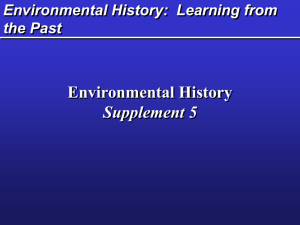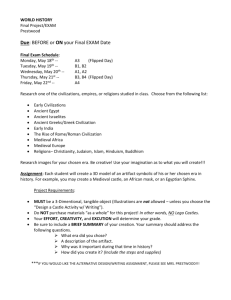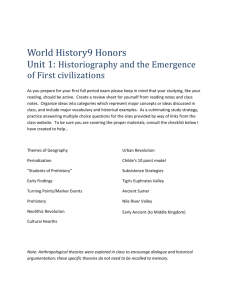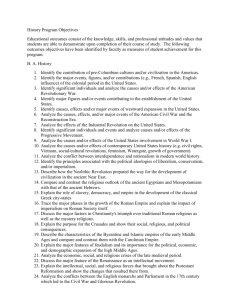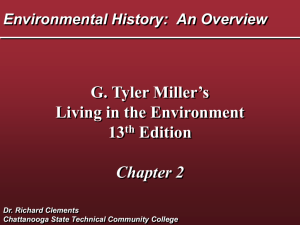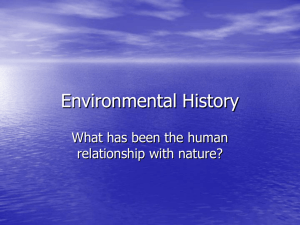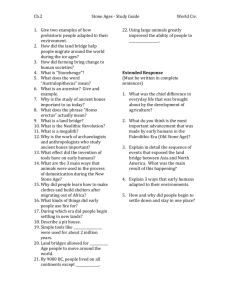History of Environmental Science
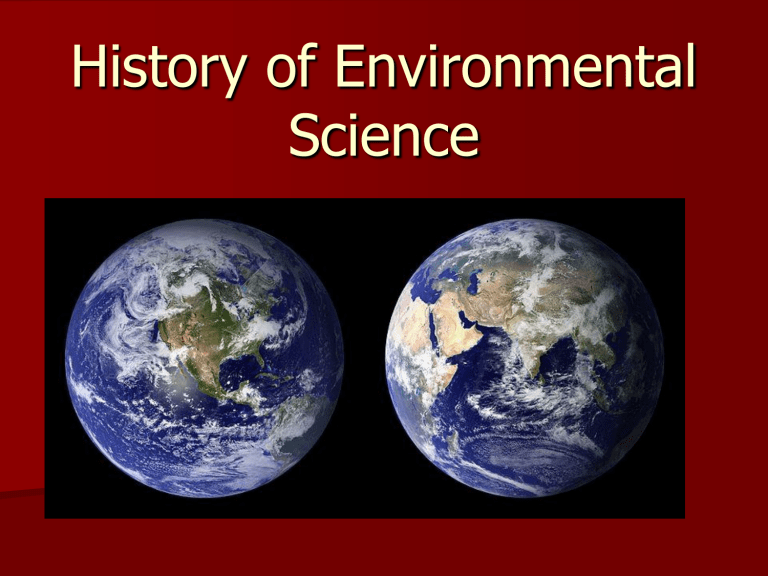
History of Environmental
Science
History of Environmental
Science
Three “revolutions” are significant in the development of environmental science
1.
Agricultural Revolution
2.
Industrial-Medical Revolution
3.
Information-Globalization Revolution
History of Environmental Science:
Agricultural Revolution
Gradual move from nomadic lifestyle of huntergatherers to the farming of domesticated animals and plants
Started about 10,000 years ago
Led to human population growth
Can you explain why???
History of Environmental Science: ancient civilizations
Ancient Rome – limited awareness of (or commitment to) environmental dangers and threats
Example: lead poisoning among upper class resulted from lead-based food containers
Example: unregulated deforestation and soil erosion may have contributed to the civilization’s downfall
History of Environmental Science ancient civilizations
Ancient Greeks – some awareness
Example: Greeks deforested much of
Greece but also solar power when wood became scarce
History of Environmental Science ancient civilizations
Ancient China, India, Peru – awareness of many environmental issues
Example: used soil conservation methods to protect against erosion
History of Environmental Science:
In U.S., Tribal era
From about 10,000 years ago to era of
European exploration
hunter/gatherers, some farming
Small environmental impact due to small population size and lifestyle
History of Environmental Science:
1200-mid1700s
Middle Ages to Renaissance – beginning of awareness of public health issues but sanitation and regulation of use of resources very limited
Example: plague devastated Europe but led to beginning of public health systems
Deforestation of much of Europe occurred during this time – led to use of coal
Frontier Era in the U.S.
1607-1890
Expansion of European influence across
North America
Clearing land, increasing use of resources, land granted by government
History of Environmental Science: mid1700s - mid1800s
Beginning of Industrial-Medical Revolution
Age of Enlightenment (approx. 1650-1800)– science progresses; thus, society’s awareness of environmental issues increased but new technologies led to pollution and other problems
Example: Ben Franklin fought against water pollution in
Philadelphia
Example: Industry pollutes air and water through use of coal, other fossil fuels (London was notorious for dirty air)
History of Environmental Science: mid1700s - mid1800s
Thomas Malthus (1766-1834) – British scholar, published essays on economics, human population growth
Believed that human populations would eventually be kept in check by famine, disease because populations grow exponentially, but food supply does not
In contrast to popular view that human populations were moving toward perfection and a Utopian society
Dr. John Snow (1854) – first to recognize a pattern in an epidemic and link it to the environment – contaminated water from one pump led to spread of cholera
Germ theory developed in 1861
History of Environmental Science:
Early Conservation Era in U.S. 1832-1960
Yellowstone established as the first US National Park
(1872)
Concern about the environment in the US was voiced in the mid 1800s by people such as Henry David Thoreau
“Alas! how little does the memory of these human inhabitants enhance the beauty of the landscape!”
Henry David Thoreau
History of Environmental Science
1880-1920
Progressive Era – reform in U.S. was happening in many fields, thus improving conditions for humans (slums, prisons, etc.) and the environment
Upton Sinclair wrote The Jungle
Teddy Roosevelt – conservationist, as president had a huge impact in setting aside natural areas
Teedy Roosevelt and John
Muir, Yosemite, 1903
History of Environmental Science
1880-1920
However, much of the preservation system was based upon utilitarian conservation-the preserving of resources so they can provide homes and jobs for people.
John Muir was a geologist, author and founder of the Sierra Club. Muir argued that nature deserved to exist for its own sake, regardless of its usefulness to us.
His view was called altruistic preservation -emphasizing the fundamental right of other organisms to exist and to pursue their own interests.
20
th
Century: A Century of
Growth
The inventions of the twentieth century had a remarkable effect on daily life. They also had a devastating effect on the environment. Human population grew tremendously.
History of Environmental Science:
1920-1940
Growing awareness of the effects of man-made threats to health and the environment, yet society continues to develop, use products and methods that are dangerous
Examples:
– Use of poisonous lead in gasoline
– Use of carcinogenic radium to make glow-in-the-dark clock faces
Women painting clocks with radium would sometimes put the brush in their mouth to fix the brush into a point. Many women developed cancer
Dr. Alice Hamilton – fought against the use of leaded gasoline; fought for the “Radium Girls” who filed a lawsuit
American Dust Bowl 1930s – due to poor agricultural practices and drought
History of Environmental
Science:1940-1960
Increasing scientific knowledge produces some things with negative environmental impact: nuclear weapons, DDT and other pesticides, synthetic materials such as plastics that are not biodegradable
Aldo Leopold –
– wrote death
Sand County Almanac , published in 1948, shortly after his
– Wrote about the ethical responsibility humans have to take care of the earth – the “land ethic”
Information-Globalization
Revolution
Starting in 1950 but especially from 1970
Development of technology to gain access to more information on a global scale
Computers, internet, phones, remote-sensing satellites
Effects are personal, cultural, environmental – what does this mean?
History of Environmental Science:
Environmental Era 1960s-present
Awakening of U.S. public to many environmental issues
Publication of Silent Spring
(1962) by Rachel Carson helps propel the modern environmental movement, raised awareness of dangers of pesticides and other chemicals
Garrett Hardin (ecologist) – wrote essay “Tragedy of the
Commons” in 1969
History of Environmental Science:
Environmental Era 1960s-present
Paul Ehrlich – ecologist, 1970s, I=PAT, wrote
Population Bomb,
which made dire predictions about the effects of overpopulation
Environmental Impact – Equation developed in the 1970s by
Paul Ehrlich, Barry Commoner, John Holdren:
I=PAT
Fig. 1-13 p. 15
History of Environmental Science:
1960s-1980s
Certain crises cause people to “think twice”, including
– nuclear accidents (Three Mile Island 1979, Chernobyl 1986)
– an extended nationwide energy shortage (1970s)
– Exxon Valdez oil spill (1989)
Increased regulation of air and water pollution
– 1970s: The Environmental Decade – passage of Clean Air Act,
Clean Water Act (Public service commerical http://www.youtube.com/watch?v=m4ozVMxzNAA )
History of Environmental Science:
1960s-1980s
More environmental activism
(e.g.,Greenpeace)
Earth Day (April 22) was started in 1970
Lois Gibbs – mom who fought for community of Love Canal that was built on a toxic waste dump (1978)
Other Names to Know
E.O. Wilson – “Mr. Biodiversity”, biologist concerned with loss of biodiversity
Jane Goodall – ground-breaking research on chimps over
45 years, conservationist
Ronald Reagan – president 1980s, “sagebrush rebel” emphasized economic development, opposed by many environmental groups
History of Environmental Science:
1990s-present
Environmentalism grows in the U.S. but many recognize the economic cost of being “green”; political factions debate issues worldwide
Global warming is supported by scientific evidence (IPCC reports, 2007 Nobel Peace Prize to IPCC and Al Gore), but is still hotly debated
Developing countries have less money to protect the environment and still face issues such as leaded gasoline
The Future - ???
Green consumers
Energy efficiency (e.g., CAFE standards)
New technology (e.g., “clean coal”)
International cooperation
Growing population
Poverty
Increasing standard of living

